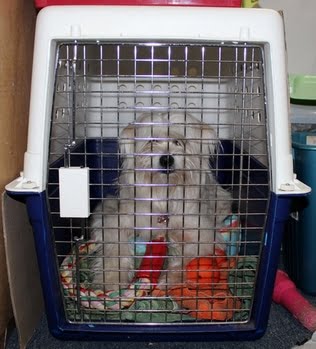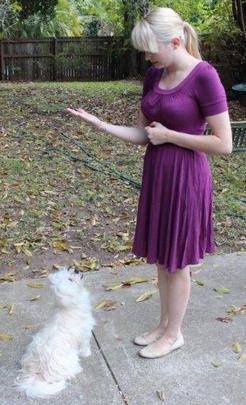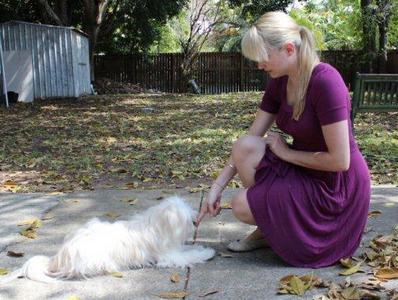Time Out (continued)

Because your goal is to reward serene, quiet behaviour, you should aim to release the pet during the trough or quietness. In that way, you are rewarding the resultant quiet behaviour.
An example will help. Bozo the Boxer is a clamorous attention seeker. His owners complained to me that he continually demands attention by heaving his massive chest and forequarters onto their lap and. If they ignore him, he licks them on the face until they have to react. If they push him off, this bossy, dog pushes back with all his might. Rarely can the owners win. Yelling and hitting are not effective as this just heightens the battle.
The first time Bozo approaches for a pat, they were to turn away or to stand up.
At the same time, they were to command SIT, initially using a food treat to create this behaviour change.
When he had been sitting serenely for five seconds, they were then to give him the pat and cuddle he wanted, but not the food. I also demonstrated how they could use the food to lure him to “LIE DOWN” beside them. When he retained this position for five seconds, they rewarded him with the food.
Can you guess what happened next? Yes – in no time at all, Bozo was up demanding attention again.
They repeated the process a second time, but this was their brick-wall limit. On the third attempt, immediately but without malice or aggression, they walked Bozo to the bathroom where they confined him for time out. After three minutes, they went to the bathroom, opened the door half-a-nose-width and commanded SIT. When Bozo obliged, they released him.


- Given him his desired attention but for the non-dominating behaviour of ‘lying down’.
- Shown him there was a limit to the amount of attention seeking tolerated.
- Shown him the continuation of attention-seeking resulted in less attention, not more, by him being ‘timed out’ and..
- That a return to serene behaviour was rewarded by him being granted access to the family again by ending his time out session.
The Progressive Praise Technique
When you have placed your dog into the time out room and barking occurs do the following three steps.
- At the first bark, tap the door and command QUIET.dog-listening-260
- Then count to five.
- If your pooch is now quiet, praise him or her, through the closed door with a joyful GOOD DOG.
Step 2
- Now count to fifteen
- If Pooch maintains its quietness, give it more praise by opening the door and, in addition to the joyful GOOD DOG reward, give the Pooch a quick a pat.
- Close the door.
Step 3
- Now count to thirty.
- If pooch has been quiet, it deserves the ultimate reward.
- Release it and give it an enthusiastic pat and the joyful GOOD DOG for its return to good behaviour.
- The progressive patting technique marries with time out comfortably.
What Behaviours Can You Use Time Out For?
You can use time out for many behaviours.
Dogs
- Attention-seeking.Dog Barking at Fence-Aggro
- Setting a limit to aggression to another in-contact dog,
- Barking at passers-by
- Cat predation
- Many other behaviours.



- Furniture scratching
- Aggression
- Hyperactive behaviour where the cats bounce around the house like fur-covered ping-pong balls with a caffeine overdose.
- Excessive noiseCockatoo.jpg
- Aggressive birds
- Feather picking
Where Can an Animal Be Timed Out?
You can employ time out in locations.
Using a laundry, bathroom or toilet is useful for dogs and cats.
However, tethering a dog to a lead attached to the leg of a piece of sturdy furniture is a form of time out. This allows for the development of ‘progressive time out’ where a misbehaving dog is moved from one tethering spot to a spot further away if its behaviour continues but, in contrast, is allowed its freedom if good behaviour returns.
You can time out a small dog or cat in a pet carry-cage and some can be secured in an over-turned laundry basket.

